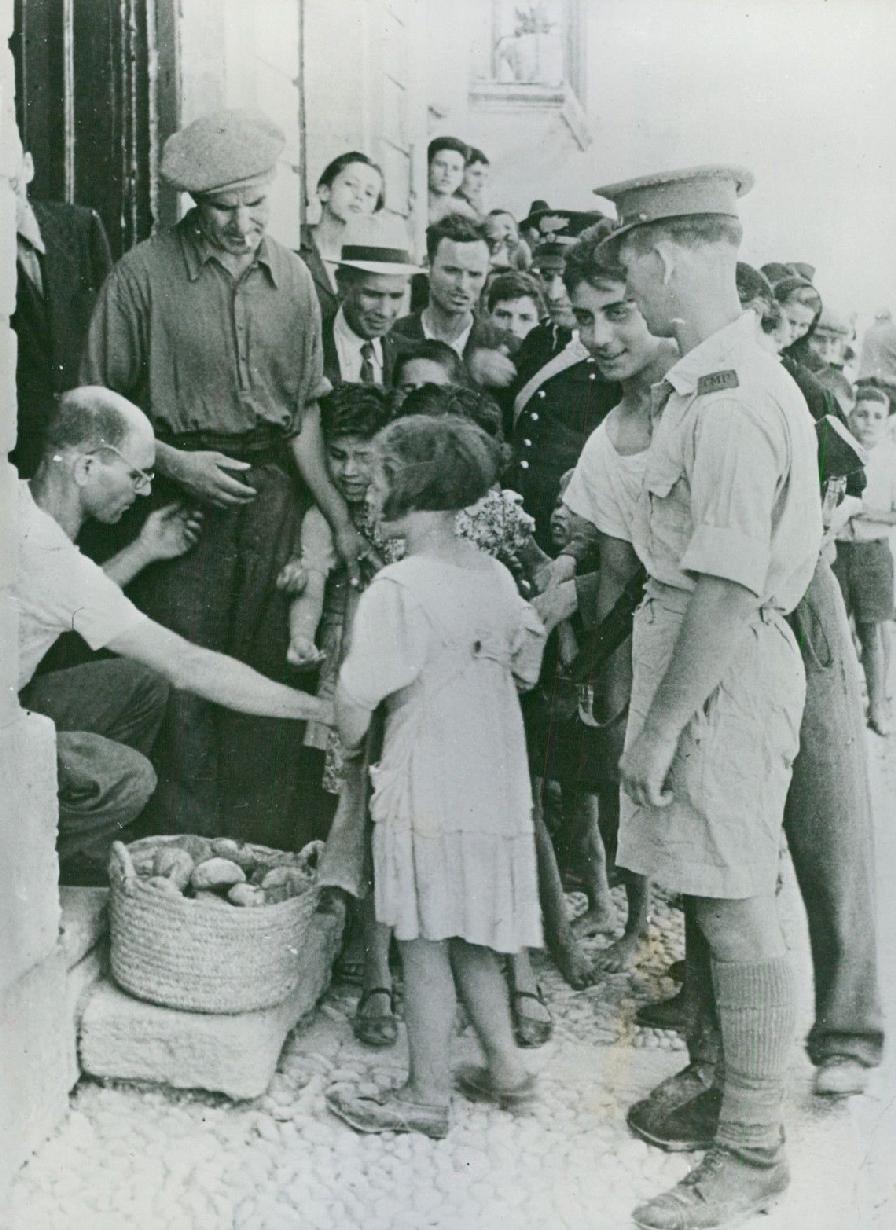
World War II: Italy -- American Military Government (1943-47)

Figure 1.--One of the most pressing jobs of the Allied Militry Government (ANG) was to see to the needs of the civilian population, most importantly water and food. Here the AMG estributes food in Sicily. The press caption reads, "Sicilian Children Receive Bread from Allies: Children at Vizzini, Sicily, get fresh bread as residents of the town line up to recive food distributed by the Allies under military supervision. This scene is being duplicated in a large number of Sciclian cities, under the allied program for rehabilittion of liberted territories." .
|
|
Military government was noting new, even to the United States. The first extensive American experiece was during the Civil War. The U.S. Army's experience during World War II, howver, was novel because of the comlexity, area of territory, and size of the population. The Allied Military Government (AMG) was first established in Sicily after the invasion of the island (July 1943). American and British civil affairs officers came ashore with the combat troops (July 10). This would be the largest undertling of military governmnt outside of Germany and Japan. The training provided AMG personel was very basic. Italy was the first Axis meember to fall, but was not guilty of war crimes on the scale of the Germans and Japanese. Article 37 of the Instrument of Surrender (September 29) gave the Allies the authority to establish a military government. The Allies created a Control Commission to administer the AMG (November 10, 1943). The governing organization was the Allied Conrol Commission (ACC) which established headquarters at the seat of the Italian Government. They also set up a field organiztion to use the Allied armies to assist the civian population. The allied military command assigned five tasks to the AMG: 1) to organize ailitary government to support combat operations, 2) to provide emergency aid to civiians to prevent dusease and ynrest, 3) to prepare a governmental administrative structure to be turned over to civilin control, 4) to supervise execution of the armistice/surrender, and 5) to serve as the sokesman of the united Nations (meaning primarily America and Britain) to the Italian Government. [Fischer, p. 114.] There was a military function, primarily to secure lines of communication. As most Italians welcomed the arrival of the Allies, seurity did not prove a major issue. The AMG found tht it most irgent task was to come to the aid of the civilans, most urgently clean water and food. The major complication was to set up set up non-Fscist local authorities. The AMG chief was was Lord Francis Rodd, 2nd Baron Rennell. The civil affairs chief was the Colonel Charles Poletti (until February 1944). The same basic system was used in Italy after the Armistace and Allied invasion (September 1943). Dealing with Fascists was largely left in the hands of the Italian civilian govrnment that the AMG helped set up, especially after Mussolini was executed by partisans.
Sources
Fisher, Thomas R. "Allied military government in Italy," The Annals of the American Academy of Political and Social Science Vol. 267, Military Government (January 1950), pp. 114-122.
CIH -- WW II

Navigate the CIH World War II Section :
[Return to Main Italian World War II occpation page]
[Return to Main Italian World War II page]
[Return to Main Italian page]
[About Us]
[Aftermath]
[Biographies]
[Campaigns]
[Children]
[Countries]
[Deciding factors]
[Diplomacy]
[Geo-political crisis]
[Economics]
[Home front]
[Intelligence]
[POWs]
[Resistance]
[Race]
[Refugees]
[Technology]
[Totalitarian powers]
[Bibliographies]
[Contributions]
[FAQs]
[Images]
[Links]
[Registration]
[Tools]
[Return to Main World War II page]
[Return to Main war essay page]
[Return to CIH Home page]
Created: 7:15 AM 5/9/2016
Last updated: 7:16 AM 5/9/2016



